Penicillin represents a groundbreaking advancement in the medical field, initially derived from the Penicillium fungi. Classified under the beta-lactam family of antibiotics, it provides a pivotal solution for managing bacterial infections in various species, particularly in cats. Its primary mechanism involves disrupting the structural integrity of bacterial cell walls, leading to bacterial cell death. While it has been a cornerstone of medical treatment for decades, its use in veterinary practices warrants careful consideration due to its specific applications, safety precautions, and the need for veterinarian oversight.
Veterinary professionals commonly prescribe penicillin to combat a range of bacterial infections in cats. The antibiotic is especially potent against gram-positive bacteria, including notorious species such as Staphylococcus and Streptococcus. In clinical settings, it is employed to manage various conditions like skin infections, respiratory ailments, urinary tract infections, and gastrointestinal disturbances. Additionally, penicillin may play a protective role for cats post-surgery or after sustaining wounds, preventing potential infections from developing.
In more severe health scenarios like septicemia—characterized by bacteria entering the bloodstream—or peritonitis, where the abdominal lining becomes inflamed, penicillin can be a vital part of the treatment protocol. It’s pertinent to note that while certain formulations of penicillin are FDA-approved for humans, their veterinary use may fall under the category of off-label prescriptions, following a veterinarian’s professional assessment. This off-label use requires diligent oversight to ensure the chosen method aligns with each cat’s specific health needs.
Dosage Considerations for Feline Patients
When determining the appropriate dosage of penicillin for cats, veterinarians consider various integral factors including the nature and gravity of the infection, the cat’s weight, and overall health condition. The medication comes in multiple forms, ranging from injectable solutions to oral tablets and liquid suspensions. For instance, Penicillin G, often administered as an injectable, usually requires a dosage range of 10,000 to 25,000 units per pound of the cat’s body weight, typically dosed multiple times throughout the day.
Conversely, for oral formulations, a dosage guideline suggests administering between 5 to 10 mg per pound of the cat’s weight, generally given once daily. Regardless of the treatment path, it is crucial to adhere strictly to the prescribed duration, which may span from seven to fourteen days. Completing the entire antibiotic course is essential to prevent the development of antibiotic-resistant bacteria, which poses a serious threat in both human and animal health.
Proper storage of penicillin is critical to maintaining its effectiveness. Oral tablets should be kept in a cool, dry area, ideally at room temperature between 68°F to 77°F, away from sunlight. In contrast, certain injectable solutions may necessitate refrigeration to uphold their stability and efficacy. Pet owners should always consult the specific storage instructions on the medication label and seek veterinary advice if there are any uncertainties.
Potential Side Effects and Risks
While penicillin is largely regarded as safe for feline use, there can be side effects associated with its administration. Commonly observed mild reactions can include gastrointestinal upset or changes in behavior, with more severe allergic reactions being rare but possible. In unusual circumstances, cats may experience secondary infections due to alterations in gut flora from prolonged antibiotic use. Veterinary professionals must be informed of any pre-existing medical issues, especially if the cat has a history of allergies to penicillin or similar antibiotics.
It’s important to remain vigilant about potential drug interactions. Treatments involving antibiotics or specific medications could interfere with penicillin therapy, thus necessitating full disclosure of your cat’s medical history to the veterinarian overseeing its care. Special caution is advised for pregnant or nursing felines, where the implications of antibiotic use may affect both the mother and her offspring.
Should a dose of penicillin be missed, pet owners are encouraged to contact their veterinarian for proper guidance on corrective action. In many instances, veterinarians may advise administering the missed dose right away; however, if the next dose is imminent, skipping the missed dose and continuing with the regular schedule is often recommended to avoid the risk of overdose.
Penicillin serves as an indispensable tool in veterinary medicine, particularly in the treatment of bacterial infections in cats. However, its application must be approached with thorough understanding, vigilant monitoring, and strict adherence to veterinary advice to ensure the safety and well-being of our feline companions.


Leave a Reply